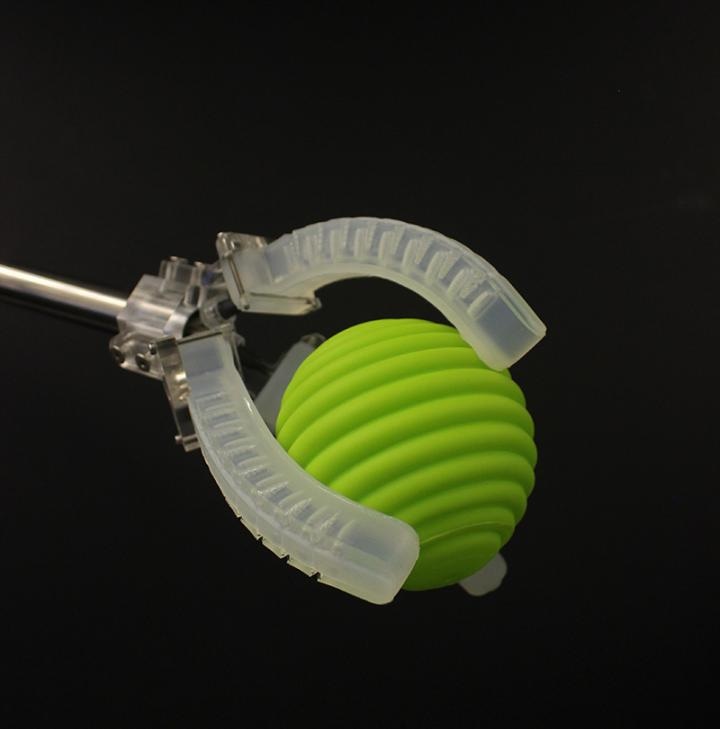Mar 1 2018
Harvard University scientists have developed nature-inspired soft robots with the ability to swim, grasp delicate objects, crawl, and even assist a beating heart. However, none of the devices can to respond to their surroundings.
 Gripper Square. Harvard researchers have developed a platform for creating soft robots with embedded sensors that can sense movement, pressure, touch, and temperature. (Image credit: Ryan L. Truby /Harvard University)
Gripper Square. Harvard researchers have developed a platform for creating soft robots with embedded sensors that can sense movement, pressure, touch, and temperature. (Image credit: Ryan L. Truby /Harvard University)
This scenario is going to be changed.
Taking a cue from the sensory capabilities of the human body, scientists from the Harvard John A. Paulson School of Engineering and Applied Sciences and the Wyss Institute for Biologically Inspired Engineering have created a platform for developing soft robots with in-built sensors with the potential to sense touch, movement, temperature, and also pressure.
The study has been reported in the Advanced Materials journal.
Our research represents a foundational advance in soft robotics. Our manufacturing platform enables complex sensing motifs to be easily integrated into soft robotic systems.
Ryan Truby, First Author & Ph.D. graduate from SEAS
Incorporating sensors into soft robots has been challenging partially because the majority of the sensors, for example, the ones used in conventional electronics, are rigid. To overcome this difficulty, the scientists produced an organic ionic liquid-based conductive ink that can be 3D printed inside the soft elastomer matrices found in a majority of the soft robots.
To date, most integrated sensor/actuator systems used in soft robotics have been quite rudimentary. By directly printing ionic liquid sensors within these soft systems, we open new avenues to device design and fabrication that will ultimately allow true closed-loop control of soft robots.
Michael Wehner, Co-Author and Postdoctoral Fellow from SEAS.
At present, Wehner is an assistant professor at the University of California, Santa Cruz.
To construct the device, the scientists depended on a well-known 3D printing method devised in the lab of Jennifer Lewis, the Hansjorg Wyss Professor of Biologically Inspired Engineering at SEAS and Core Faculty Member of the Wyss Institute. The method, called embedded 3D printing, has the potential to rapidly and seamlessly incorporate several materials and features into a single soft body.
“This work represents the latest example of the enabling capabilities afforded by embedded 3D printing - a technique pioneered by our lab,” stated Lewis.
“The function and design flexibility of this method is unparalleled,” stated Truby. “This new ink combined with our embedded 3D printing process allows us to combine both soft sensing and actuation in one integrated soft robotic system.”
For investigating the sensors, the researchers printed a soft robotic gripper including three soft fingers or actuators. The scientists investigated the potential of the gripper to sense contact, inflation pressure, temperature, and curvature. They integrated several contact sensors so that the gripper can sense deep touches and light.
Soft robotics are typically limited by conventional molding techniques that constrain geometry choices, or, in the case of commercial 3D printing, material selection that hampers design choices. The techniques developed in the Lewis Lab have the opportunity to revolutionize how robots are created—moving away from sequential processes and creating complex and monolithic robots with embedded sensors and actuators.
Robert Wood - Co-Author, Charles River Professor of Engineering & Applied Sciences at SEAS & Core Faculty Member of the Wyss Institute
The next step of the scientists would be to tap the potential of machine learning to teach these devices to get hold of objects of differing shape, temperature, size, and surface texture.
Abigail Grosskopf, Daniel Vogt, and Sebastien Uzel are the other co-authors of the study. The Harvard MRSEC and the Wyss Institute for Biologically Inspired Engineering partially supported the research.